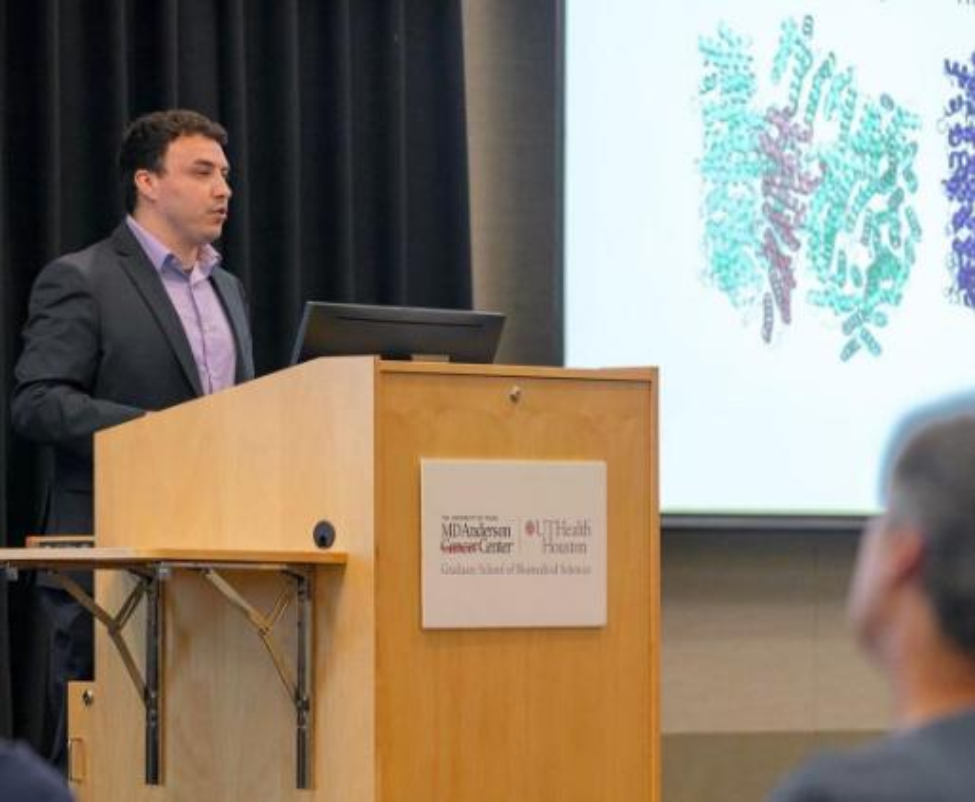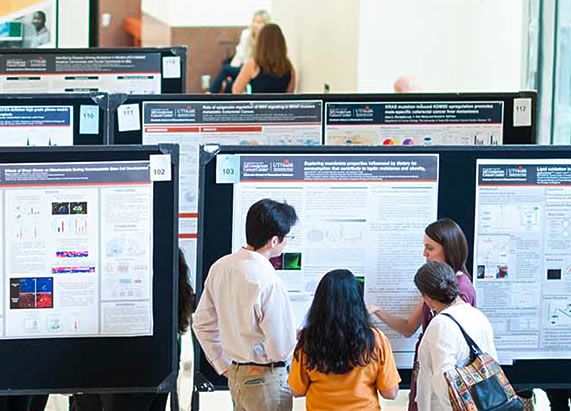October’s Paper of the Month reveals how a conserved protein complex across species may unlock new clues to Huntington’s disease
October 31, 2025 By: Altai Enkhbayar/Graduate Student/Cancer Biology Program/The University of Texas MD Anderson Cancer Center UTHealth Houston Graduate School of Biomedical Sciences



Paper of the Month: Structural-functional Analyses of the Huntingtin/HAP40 Complex in Drosophila and Humans
The answers to some of the most devastating human diseases may lie in the biology we share with the simplest of organisms. Evolutionary conserved genes and protein structures, preserved across millions of years and countless species, often hold the key to understanding the fundamental mechanisms underlying human pathologies. Despite the vast evolutionary distance between humans and model organisms like Drosophila melanogaster, about 75% of human disease-related genes are conserved across these systems. In addition to its genetic similarity, Drosophila offers several practical advantages in laboratory research, including low cost, ease of maintenance, and well-established tools for genetic manipulation. Stephen Farmer, a PhD candidate in Molecular & Translational Biology and Neuroscience programs, leveraged this powerful genetic model in his recent publication in the Journal of Biomolecular Structure and Dynamics to uncover potential therapeutic targets for Huntington’s disease.
Around 40,000 people in the United States today suffer from Huntington’s disease (HD), a fatal neurodegenerative disorder. While healthy individuals have around 20 repeats of CAG trinucleotide sequence in their huntingtin gene, HD patients often have abnormal expansion of this repeat, reaching 40 or more. This pathogenic expansion results in elongated polyglutamine (polyQ) tract in the huntingtin protein (HTT) impairing its function. As Farmer notes, “Despite its simple genetic cause, there are still no treatments or cures, primarily due to a still incomplete understanding of HTT’s normal physiological function(s).” In 2018, when the structure of full-length HTT was resolved by cryo-electron microscopy, this invited many research labs like Sheng Zhang, PhD’s Lab of UTHealth Houston's Brown Foundation Institute of Molecular Medicine to pursue structure-guided search targeting mutant HTT as a therapeutic strategy against HD.
HAP40: A critical regulator of HTT conserved from model systems to humans
It was revealed in the study that HTT never acts alone, but instead forms a stable complex with another protein, HAP40. Following this, the Zhang lab characterized HAP40 to be necessary and critical partner for HTT’s function (PLOS Genetics) and proposed it as a potential modulator of HD pathogenesis using the Drosophila model. They observed that physical and functional interactions of HTT and HAP40 are highly conserved from model organisms to humans. When Farmer joined his mentor’s team, he asked what degree their 3D structures were conserved and whether that structural conservation is functionally relevant in the context of disease.
“We wanted to know whether HTT and HAP40, which have surprisingly low sequence identity between Drosophila and humans, might nevertheless adopt similar structural folds or at least share conserved structural domains.”
Modeling protein structures and interactions using AI-based tool
While the structures of human HTT and HAP40 were experimentally determined, the Drosophila orthologs of HTT (dHtt) and HAP40 (dHap40) had not yet been structurally resolved. A key challenge in Farmer’s project was therefore to model the structure and interactions of the Drosophila dHTT-dHAP40 complex. As he explains, “Accurately modeling such large proteins, especially protein-protein complexes, has been historically challenging. Drosophila HTT is 3,583 amino acids (AAs) long and HAP40 is 345 AAs, which makes them too large for most comparative modeling tools.” Farmer notes that the release of AlphaFold3 enabled them to overcome this challenge and predict the dHtt-dHap40 complex. Based on the human HTT-HAP40 structure, they generated a full-length protein model for the Drosophila orthologs. Farmer stated that, to their surprise, despite sharing less than 30% sequence identity with their human counterparts, the Drosophila orthologs shared remarkably similar structural topologies and interface contacts.
Cracking the “structure to function” code of HTT-HAP40 complex
Farmer combined an experimental mutagenesis approach with computational modeling to dissect which structural elements of the HTT-HAP40 complex play key roles in mediating the binding between two proteins. He and the co-authors found that there are six salt bridges and four hydrogen bonds at the binding interface of HTT-HAP40 conserved both in Drosophila and humans. Using standard amino acid sequence alignment alone, it would have been impossible to detect these conserved interactions. However, comparative structural modeling of human and Drosophila complexes revealed a striking degree of evolutionary conservation of HTT-HAP40. More interestingly, these 10 interaction bridges proved to be crucial for the stability of the complex, as evidenced by reduced endogenous HTT levels when interacting HAP40 amino acids were substituted with alanine residues.
Furthermore, Farmer and his colleagues stumbled across a unique section of HAP40 (BΦ motif) which extends outward from the complex and is exposed to the solvent. The free-floating yet highly conserved nature of BΦ motif led the team to hypothesize that the BΦ motif of HAP40 is dispensable for HTT stabilization but essential for its activity. Their mutagenesis efforts revealed that replacing HAP40 BΦ motif with linker sequence does not affect HTT expression levels or stability. Moreover, HAP40 knockout (KO) Drosophila overexpressing HAP40 with a mutated BΦ motif could not rescue their reduced survival i.e. mirroring HAP40-KO alone, as compared to HAP40-KO Drosophila expressing full-length HAP40 (‘rescued Drosophila’). Consistently, when the HAP40 BΦ mutant was co-overexpressed with HTT, it failed to induce a unique neuronal gain-of-function ‘no-eye’ phenotype that occurs when wild-type HAP40 is co-overexpressed with HTT. These results supported their hypothesis that BΦ is an important functional domain for the HTT-HAP40 complex. Farmer excitingly shares, “It was especially rewarding to see AlphaFold3 predictions identify a conserved piece on HAP40 (BΦ) that proved functionally necessary for HTT in a living system, laying the foundation for follow-up studies to test whether targeting this region can modulate mutant HTT toxicity and HD pathogenesis.”
These findings underscore the power of comparative biology and structural analysis in uncovering conserved mechanisms that may be leveraged to combat neurodegenerative diseases such as Huntington’s disease. Reflecting on his journey of writing this article, Farmer noted, “Working as a team within our lab was a highlight of this project. It showed me how combining expertise in computational modeling, genetics, cell culture-based methods, and clinical perspectives can accelerate discovery in ways [that] no single approach could achieve.” He also credits former undergraduate student, Amy Gao, for her early computational findings on HTT-HAP40 segments conserved across species which laid the foundation for detailed molecular modeling and experimental mutagenesis. “It was this creative, outside-the-box thinking that ultimately provided the spark for this project.”
Farmer’s first-author paper is just one of many achievements he has accomplished at the Graduate School. He receives current and prior National Institutes of Health (NIH) support through NINDS F99/K00 Predoctoral-to-Postdoctoral Transition Grant (D-SPAN) and TL1 Predoctoral Training Grant. In addition, he has been honored with several prestigious awards, including this year’s President’s Research Scholarship and the Thomas F. Burks Scholarship for Academic Merit, as well as Graduate School awards that directly supported this manuscript including the President’s Research Excellence Award and the Dr. John J. Kopchick Fellowship. For his PhD dissertation work, Farmer is now further exploring how the BΦ motif of HAP40 influences HTT localization and function, particularly in endolysosomal trafficking, a major cellular homeostasis process disrupted in Huntington’s disease.
Paper of the Month (POM) is a collaborative effort led by Microbiology and Infectious Diseases PhD candidate Jana Gomez and Communications Manager Shelli Manning, and overseen by Associate Dean for Academic Affairs Francesca Cole, PhD, who work with students to summarize fellow student-authored scientific articles about their biomedical science research and the innovative methods and discoveries they are uncovering. The POM editorial team includes students Shraddha Subramanian, Mirrah Bashir, Amanda Warner (author of September’s POM summary), Chae Yun Cho, Altai Enkhbayar, Zarmeen Khan, Archit Gupta, and Sheighlah McManus.







